Conference Report: Mary Shelley's Frankenstein in Bologna
Today we're thrilled to present this summary of a superb Frankenstein-themed conference in Italy. Mary Shelley's Frankenstein: Circuits and Circulation took place in September 2018 in Bologna. Valentina Pramaggiore reports...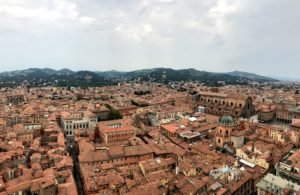
Mary Shelley’s Frankenstein 1818-2018: Circuits and Circulation
by Valentina Pramaggiore
The two-day Joint International Conference dedicated to “Mary Shelley’s Frankenstein 1818-2018: Circuits and Circulation” took place in the wonderful historical location of S. Giovanni in Monte—a former monastery built in 1543. The conference was organized by the Inter-university Centre for the Study of Romanticism (CISR) and the Department of Languages, Literatures and Modern Cultures of the University of Bologna. The conference, scheduled for the 20th and 21st of September 2018, was also co-organized by Cardiff University, the Open University, ERA (European Romanticisms in Association) network, and BARS (British Association for Romantic Studies) to celebrate the bicentenary of the publication of Mary Shelley’s Frankenstein.The main points of discussion during the conference were the multiple networks that have helped Frankenstein circulate from its original publication in 1818 and throughout the centuries, making the novel one of the most important works of fiction in the history of literature, as well as a popular icon for the modern collective imagination. Such an enlarged framework of analysis allowed the symposium to address both the novel’s pivotal role in shaping new perceptions of literature and science during the nineteenth century and its modern reception too, thus encouraging a re-evaluation of the text in relation to many different key contexts: the scientific culture of the time, Mary Shelley’s familial and intellectual circles, gender dynamics, transnational networks, editions, literary sources and models, translations and adaptations, and more recent critical readings.This event gathered together an extensive number of Italian and international Romanticism scholars, as well as experts on Mary Shelley and Frankenstein. A half-day pre-conference was also organized on September 19th, with the call for papers open to PhD candidates and early career researches who contributed to the celebration by delivering talks.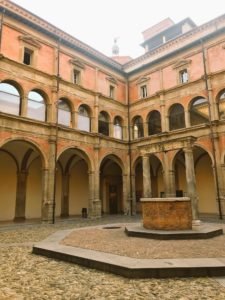
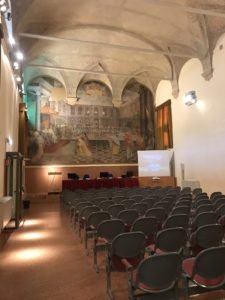 The afternoon of the pre-conference started with a welcome speech delivered by the organizers in the beautiful setting of Aula Prodi—the former refectory of the monastery complex which now hosts a magnificent lecture hall, enriched by a prestigious fresco executed by Bartolomeo Cesi in the XVI century. The two sessions, “Circulating the Self” and “Intertextual Circuits”, saw PhD candidates and early career researchers, from Italian and British Universities, present stimulating papers on a variety of subjects which included: a notebook of the Shelleys containing P B Shelley's review of Frankenstein, literary and cultural otherness, the representation of the feminine and the angel/monster dichotomy in the novel, Dante in Frankenstein, the criminal mind, Thanatographies and anatomy of death, Victor’s new life in Penny Dreadful, gender issues and performance, and the burlesque afterlives of the text.
The afternoon of the pre-conference started with a welcome speech delivered by the organizers in the beautiful setting of Aula Prodi—the former refectory of the monastery complex which now hosts a magnificent lecture hall, enriched by a prestigious fresco executed by Bartolomeo Cesi in the XVI century. The two sessions, “Circulating the Self” and “Intertextual Circuits”, saw PhD candidates and early career researchers, from Italian and British Universities, present stimulating papers on a variety of subjects which included: a notebook of the Shelleys containing P B Shelley's review of Frankenstein, literary and cultural otherness, the representation of the feminine and the angel/monster dichotomy in the novel, Dante in Frankenstein, the criminal mind, Thanatographies and anatomy of death, Victor’s new life in Penny Dreadful, gender issues and performance, and the burlesque afterlives of the text. 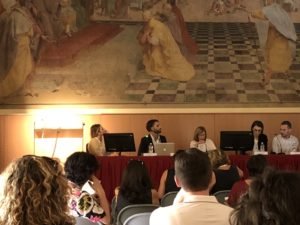 The pre-conference ended with an evening reception in the historical cloister of the premises, followed by an amazing voice and piano concert titled “Arie Romantiche”, during which the soprano singer Annamaria Amorosa, accompanied by the pianist Diletta Pompei, sang some extracts of Operas of the Romantic period, such as La Traviata by Verdi and Gretchen am Spinnrade by Schubert.
The pre-conference ended with an evening reception in the historical cloister of the premises, followed by an amazing voice and piano concert titled “Arie Romantiche”, during which the soprano singer Annamaria Amorosa, accompanied by the pianist Diletta Pompei, sang some extracts of Operas of the Romantic period, such as La Traviata by Verdi and Gretchen am Spinnrade by Schubert.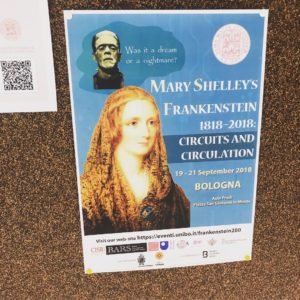 The main Conference opened on September 20th, with the welcoming remarks by Enrico Sangiorgi (Vice-rector for teaching and education of the U of Bologna), Paola Puccini (Head of the Department of Languages, Literatures and Modern Cultures), and the conference organizers: Lilla Maria Crisafulli (U of Bologna and Director of the Inter-university Centre for the Study of Romanticism), Serena Baiesi (U of Bologna and member of CISR), Anthony Mandal (U of Cardiff and Vice-President of BARS), and Nicola Watson (Open University and Coordinator of ERA).The first session put the spotlight on the Gothic genre and its relation to Mary Shelley’s Frankenstein. Andrew Smith (U of Sheffield) explored the role of Frankenstein in establishing a model of Gothic subjectivity that inspired many other famous texts of the nineteenth century, and the discussion about the inheritance of the Gothic continued with Serena Baiesi (U of Bologna)’s talk about Mary Shelley’s short stories—published in various annuals, from 1823 to 1839—and their connection to the Gothic genre and Italian context. Subsequently, Mary Shelley’s interest in the Gothic was explored by Angela Wright (U of Sheffield), who examined the relation of both the 1818 and 1831 edition of Frankenstein to the Gothic genre, demonstrating why the 1831 version fit more easily into such a literary category.Other interesting sessions were dedicated to Mary Shelley’s intellectual circles, the relationship between the author and science, and the monstrous body, a topic that was also addressed during the first plenary lecture, delivered by Lilla Maria Crisafulli (U of Bologna) and titled “Rewriting the Body / Reconstructing the World in Mary Shelley’s Frankenstein”. Specifically, Crisafulli discussed the notion of modernity and “modernities” in relation to feminist studies and the body as the site of social construction, highlighting how both concepts can create otherness and marginalization when excluding whoever does not conform.Monsters, myth and sources were the multifaceted topics of the third session, during which Keir Elam (U of Bologna) analysed the interrelation between Shelley, Shakespeare and the notion of monstrosity in the early modern period, while Maximiliaan Van Wouderberg (Sheridan Institute of Technology) investigated two ghost stories - “The Gray Room” and “The Black Chamber” - included in the collection Fantasmagoriana, known to have inspired the literary contest in Villa Diodati. The session ended with Lia Guerra (U of Pavia), who examined Mary Shelley’s use of the myth in her early literary production, as well as in her mythological dramas Proserpine and Midas.
The main Conference opened on September 20th, with the welcoming remarks by Enrico Sangiorgi (Vice-rector for teaching and education of the U of Bologna), Paola Puccini (Head of the Department of Languages, Literatures and Modern Cultures), and the conference organizers: Lilla Maria Crisafulli (U of Bologna and Director of the Inter-university Centre for the Study of Romanticism), Serena Baiesi (U of Bologna and member of CISR), Anthony Mandal (U of Cardiff and Vice-President of BARS), and Nicola Watson (Open University and Coordinator of ERA).The first session put the spotlight on the Gothic genre and its relation to Mary Shelley’s Frankenstein. Andrew Smith (U of Sheffield) explored the role of Frankenstein in establishing a model of Gothic subjectivity that inspired many other famous texts of the nineteenth century, and the discussion about the inheritance of the Gothic continued with Serena Baiesi (U of Bologna)’s talk about Mary Shelley’s short stories—published in various annuals, from 1823 to 1839—and their connection to the Gothic genre and Italian context. Subsequently, Mary Shelley’s interest in the Gothic was explored by Angela Wright (U of Sheffield), who examined the relation of both the 1818 and 1831 edition of Frankenstein to the Gothic genre, demonstrating why the 1831 version fit more easily into such a literary category.Other interesting sessions were dedicated to Mary Shelley’s intellectual circles, the relationship between the author and science, and the monstrous body, a topic that was also addressed during the first plenary lecture, delivered by Lilla Maria Crisafulli (U of Bologna) and titled “Rewriting the Body / Reconstructing the World in Mary Shelley’s Frankenstein”. Specifically, Crisafulli discussed the notion of modernity and “modernities” in relation to feminist studies and the body as the site of social construction, highlighting how both concepts can create otherness and marginalization when excluding whoever does not conform.Monsters, myth and sources were the multifaceted topics of the third session, during which Keir Elam (U of Bologna) analysed the interrelation between Shelley, Shakespeare and the notion of monstrosity in the early modern period, while Maximiliaan Van Wouderberg (Sheridan Institute of Technology) investigated two ghost stories - “The Gray Room” and “The Black Chamber” - included in the collection Fantasmagoriana, known to have inspired the literary contest in Villa Diodati. The session ended with Lia Guerra (U of Pavia), who examined Mary Shelley’s use of the myth in her early literary production, as well as in her mythological dramas Proserpine and Midas.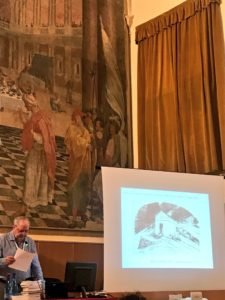 The final section of the conference hosted a second plenary presentation delivered by Stuart Curran (U of Pennsylvania) and dedicated to “Frankenstein: Matters of Fact”. Employing a wide range of interesting visual resources, Curran displayed and questioned the detailed historical and geographical elements mentioned in the narration in order to explore their significance for the interpretation of the text.The first day of conference ended with a sightseeing bus tour of Bologna, followed by the social dinner. The dinner took place in the suggestive location of Villa Benni, a splendid mansion surrounded by a beautiful park, built at the beginning of the twentieth century, that certainly held a special allure for the beautiful al fresco aperitivo and the splendid three-course meal in the elegant interior.
The final section of the conference hosted a second plenary presentation delivered by Stuart Curran (U of Pennsylvania) and dedicated to “Frankenstein: Matters of Fact”. Employing a wide range of interesting visual resources, Curran displayed and questioned the detailed historical and geographical elements mentioned in the narration in order to explore their significance for the interpretation of the text.The first day of conference ended with a sightseeing bus tour of Bologna, followed by the social dinner. The dinner took place in the suggestive location of Villa Benni, a splendid mansion surrounded by a beautiful park, built at the beginning of the twentieth century, that certainly held a special allure for the beautiful al fresco aperitivo and the splendid three-course meal in the elegant interior.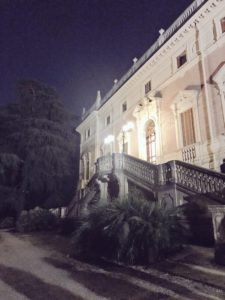
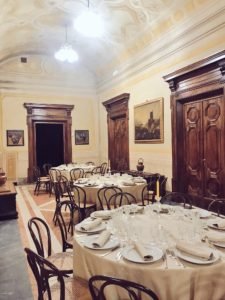
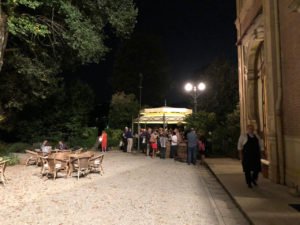 The second day of the conference started with the plenary lecture delivered by Nora Crook (Anglia Ruskin U, Cambridge) and amusingly titled “The Cinderella of the Frankenstein Editions”, referring to the 1823 edition of the novel. In her talk, Crook explained in details the context in which this second edition of Frankenstein was published, pinpointed the many differences to the 1818 version, and underlined its fundamental role for the re-writing of the 1831 volume.
The second day of the conference started with the plenary lecture delivered by Nora Crook (Anglia Ruskin U, Cambridge) and amusingly titled “The Cinderella of the Frankenstein Editions”, referring to the 1823 edition of the novel. In her talk, Crook explained in details the context in which this second edition of Frankenstein was published, pinpointed the many differences to the 1818 version, and underlined its fundamental role for the re-writing of the 1831 volume.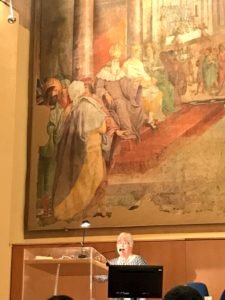 Further sessions scheduled for the second day tackled various fascinating subjects, including Frankenstein and the post-human alterity in the twenty-first century, discussed by Anthony Mandal (U of Cardiff); Mary Shelley and obstetrical issues, examined by Richard Sha (American U); children's literature inspired by the novel, analysed by Emily Alder (Edinburgh Napier U); and a re-reading of Frankenstein as an archetype for psychological thrillers, suggested by Maurizio Ascari (U of Bologna).The final sessions of the conference focused on the adaptation of Frankenstein across time in the movie industry, and in media, theatrical performances and TV series. Frederick Burwick (U of California) presented the figure of Thomas Potter Cooke, the actor who interpreted with greater success the role of the monster on the nineteenth century English stage, while Carlotta Farese (U of Bologna) brought the audience to the 1950s with her analysis of Joseph Mankiewicz’s movie People Will Talk, of which she underlined the intertextual references to the novel. Moving forward in time, Gino Scatasta (U of Bologna) introduced the various film adaptations of Frankenstein that came out in Great Britain in the 1960s, examining the relation between the choice of the subject and the historical and cultural context.At the end of the second day Gilberta Golinelli (U of Bologna) investigated an episode of The X-Files emblematically titled “The Post-Modern Prometheus”, and Saverio Tomaiuolo (U of Cassino) explored the connection between the novel and the 2014 TV series Penny Dreadful.The closing remarks included two appealing launches: Nicola Watson (Open U) introduced the RêVE website and their virtual exhibition; and Nick Groom (U of Exeter) talked about his new edition of Mary Shelley’s Frankenstein for Oxford University Press. A drink reception and guided visits to museums took place as a perfect conclusion to such an engaging and thought-provoking two-day conference in Bologna.
Further sessions scheduled for the second day tackled various fascinating subjects, including Frankenstein and the post-human alterity in the twenty-first century, discussed by Anthony Mandal (U of Cardiff); Mary Shelley and obstetrical issues, examined by Richard Sha (American U); children's literature inspired by the novel, analysed by Emily Alder (Edinburgh Napier U); and a re-reading of Frankenstein as an archetype for psychological thrillers, suggested by Maurizio Ascari (U of Bologna).The final sessions of the conference focused on the adaptation of Frankenstein across time in the movie industry, and in media, theatrical performances and TV series. Frederick Burwick (U of California) presented the figure of Thomas Potter Cooke, the actor who interpreted with greater success the role of the monster on the nineteenth century English stage, while Carlotta Farese (U of Bologna) brought the audience to the 1950s with her analysis of Joseph Mankiewicz’s movie People Will Talk, of which she underlined the intertextual references to the novel. Moving forward in time, Gino Scatasta (U of Bologna) introduced the various film adaptations of Frankenstein that came out in Great Britain in the 1960s, examining the relation between the choice of the subject and the historical and cultural context.At the end of the second day Gilberta Golinelli (U of Bologna) investigated an episode of The X-Files emblematically titled “The Post-Modern Prometheus”, and Saverio Tomaiuolo (U of Cassino) explored the connection between the novel and the 2014 TV series Penny Dreadful.The closing remarks included two appealing launches: Nicola Watson (Open U) introduced the RêVE website and their virtual exhibition; and Nick Groom (U of Exeter) talked about his new edition of Mary Shelley’s Frankenstein for Oxford University Press. A drink reception and guided visits to museums took place as a perfect conclusion to such an engaging and thought-provoking two-day conference in Bologna.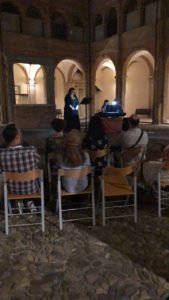 Valentina Pramaggiore is currently a PhD Candidate in European Literatures – Curriculum EDGES Women’s and Gender Studies at the University of Bologna. Her current research interests include women’s and gender studies related to both English and comparative literatures, especially the rediscovery of romantic women writers and their works. Her PhD thesis is focused on the tragedies written by romantic women playwrights in English, Italian and Spanish literature, analysed from a feminist critical perspective. Enjoyed this? See the report from the 2018 Mary Shelley conference in Carrara, Italy here.
Valentina Pramaggiore is currently a PhD Candidate in European Literatures – Curriculum EDGES Women’s and Gender Studies at the University of Bologna. Her current research interests include women’s and gender studies related to both English and comparative literatures, especially the rediscovery of romantic women writers and their works. Her PhD thesis is focused on the tragedies written by romantic women playwrights in English, Italian and Spanish literature, analysed from a feminist critical perspective. Enjoyed this? See the report from the 2018 Mary Shelley conference in Carrara, Italy here.

